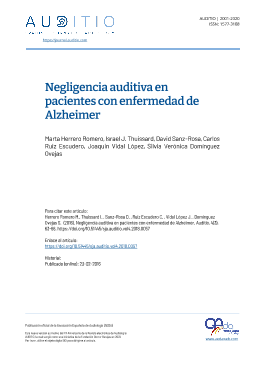Auditory neglect in patients with Alzheimer's disease
DOI:
https://doi.org/10.51445/sja.auditio.vol4.2018.0057Keywords:
Negligencia auditiva, Alzheimer, Test de dígitos dicóticosAbstract
Introduction. Hearing neglect is a dysfunction of the central nervous system that causes difficulties in responding to a stimulus on the opposite side of the injury, when sounds or words are presented by both ears at the same time.
The main objective of this work is to assess the existence of auditory neglect in patients with grade I Alzheimer's disease.
Material and methods. In this work, 32 individuals have been analyzed, divided into two groups. 16 patients diagnosed with grade I Alzheimer's disease and 16 control individuals (without Alzheimer's disease or other neurological pathologies). The ages of the subjects were between 60 and 95 years. For the assessment of auditory neglect, the Auditory test and the Dichotic Digits Test were applied.
Results. The Auditory test detected that when two simultaneous stimuli were presented by both ears, patients with Alzheimer's disease grade I perceived 72.5% of the tones through the left ear, likewise, the results of the Dichotic Digits Test showed a lower number of hits in the right ear of these patients. The results of both the Auditory tests and the Dichotic Digits Test performed on the control group did not show statistically significant differences between the two ears.
Conclusion. The results obtained suggest that patients with grade I Alzheimer's disease have left auditory neglect.
Downloads
Visibility and Altmetrics
Metrics
References
Álvarez M, PedrosoI, de la Fe A, Padrón A, Álvarez M, Álvarez L. (2008). Fisiopatología de la enfermedad de Alzheimer. Revista Mexicana de Neurociencia, (3), 196-201
Bellmann A, Meuli C, Clarke S. (2001). Two types of auditory neglect. Brain, (124), 676-687 https://doi.org/10.1093/brain/124.4.676
Gates GA, Karzon RK, Garcia P, Peterein J, Storandtn M, Morris JC, Miller JP. (1995). Auditory dysfunction in aging and senile dementia of the Alzheimer's type. Archives of Neurology, (52), 626- 634. https://doi.org/10.1001/archneur.1995.00540300108020
Halligan PW, Marshall JC. (1994). Toward a principled explanation of unilateral neglect. Cognitive Neuropsycholy, (11), 167-206. https://doi.org/10.1080/02643299408251973
Heilman KM, Valenstein E. (1972). Auditory neglect in man. Archives of Neurology, (26), 32-35. https://doi.org/10.1001/archneur.1972.00490070050007
Iliadou V, Lakovides S. (2003). Contribution of psychoacoustics and neuroaudiology in revealing correlation of mental disorders with central auditory processing disorders. General Hospital Psychiatry, (2), 5.
Kimura D. (1967). Functional Asymmetry of the Brain in Dichotic Listening. Cortex, (3), 163-178. https://doi.org/10.1016/S0010-9452(67)80010-8
Mendez M, Cherrier M, Cymerman J. (1997). Hemispatial Neglect on Visual Search Tasks in Alzheimer's disease. Neuropsychiatry, Neuropsycholy and Behavioral Neurology, (3), 203-208.
Peña-Casanova J. (2007). Neurología de la conducta y neuropsicología. Editorial Médica Panamericana (11-12). 10.Renzi E, Gentilini M, Barbieri C. (1989). Auditory neglect. Journal of Neurology, Neurosurgery, and Psychiatry, (52), 613-617. https://doi.org/10.1136/jnnp.52.5.613
Ringman JM, Saver JL. Woolson RF, Clarke WR. Adams HP. (2004). Frequency, risk factors, anatomy, and course of unilateral neglect in an acute stroke cohort. Neurology, (63), 468-474. https://doi.org/10.1212/01.WNL.0000133011.10689.CE
Williams JM, Coleman AR. (2008). Sound Stimulus Qualities and Severe Auditory Neglect. Neurocase, (14), 223-230. https://doi.org/10.1080/13554790802108406
Zenker F, Suárez M, Marro S, Barajas de Prat JJ. (2007). La evaluación del procesamiento auditivo central: Test de dígitos dicóticos. AELFA, (27), 74-85. https://doi.org/10.1016/S0214-4603(07)70076-1

Published
Versions
- 2021-09-15 (2)
- 2016-02-23 (1)
How to Cite
Issue
Section
License
Copyright (c) 2016 Asociación Española de Audiología

This work is licensed under a Creative Commons Attribution 3.0 Unported License.
Articles published after 2020
Authors retain copyright and grant the journal right of first publication with the work simultaneously licensed, unless otherwise indicated, under a Creative Commons Attribution License that allows others to share the work with an acknowledgement of the work's authorship and initial publication in this journal. The authors can choose between the following Creative Commons licenses: https://creativecommons.org/about/cclicenses/
Articles published between 2001 and 2020
The texts published in this journal in the section "AUDITIO 2001-2020" are subject - unless otherwise indicated - to a Creative Commons Attribution 3.0 Spain license. You can copy, distribute, communicate them publicly, make derivative works and commercial uses provided that you acknowledge the credits of the works (authorship, name of the journal, publishing institution) in the manner specified by the authors or by the journal. The full license can be consulted at http://creativecommons.org/licenses/by/3.0/es/deed.es.









